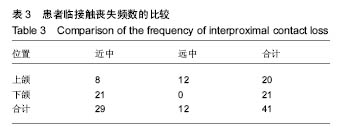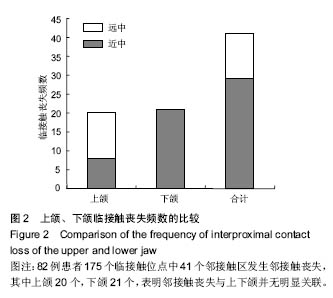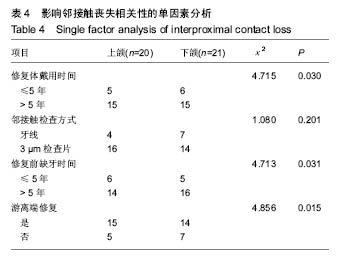| [1]孙建军. 159例上颌前牙缺失修复术临床治疗效果研究[J].中外医疗,2014,30(2):36-37.[2]Thoma DS, Cha JK, Jung UW.Treatment concepts for the posterior maxilla and mandible: short implants versus long implants in augmented bone.J Periodontal Implant Sci. 2017; 47(1):2-12.[3]Thoma DS, Zeltner M, Hüsler J, et al.EAO Supplement Working Group 4 - EAO CC 2015 Short implants versus sinus lifting with longer implants to restore the posterior maxilla: a systematic review.Clin Oral Implants Res. 2015; 26 Suppl 11: 154-169.[4]Esposito M, Cannizzaro G, Soardi E, et al.Posterior atrophic jaws rehabilitated with prostheses supported by 6 mm-long, 4 mm-wide implants or by longer implants in augmented bone. Preliminary results from a pilot randomised controlled trial.Eur J Oral Implantol. 2012 Spring; 5(1):19-33.[5]Wittneben JG, Millen C, Brägger U.Clinical performance of screw- versus cement-retained fixed implant-supported reconstructions--a systematic review.Int J Oral Maxillofac Implants. 2014; 29 Suppl:84-98.[6]Sailer I, Mühlemann S, Zwahlen M, et al.Cemented and screw-retained implant reconstructions: a systematic review of the survival and complication rates.Clin Oral Implants Res. 2012; 23 Suppl 6:163-201.[7]Kim SG, Park JU, Jeong JH, et al.In vitro evaluation of reverse torque value of abutment screw and marginal opening in a screw- and cement-retained implant fixed partial denture design.Int J Oral Maxillofac Implants. 2009; 24(6):1061-1067.[8]Khammissa RA, Feller L, Meyerov R, et al.Peri-implant mucositis and peri-implantitis: clinical and histopathological characteristics and treatment.SADJ. 2012; 67(3):122, 124-126.[9]Krennmair S, Seemann R, Weinländer M, et al. Immediately loaded distally cantilevered fixed mandibular prostheses supported by four implants placed in both in fresh extraction and healed sites: 2-year results from a prospective study.Eur J Oral Implantol. 2014 Summer; 7(2):173-184.[10]Le M, Papia E, Larsson C.The clinical success of tooth- and implant-supported zirconia-based fixed dental prostheses. A systematic review.J Oral Rehabil. 2015; 42(6):467-480.[11]Pjetursson BE, Sailer I, Makarov NA, et al.All-ceramic or metal-ceramic tooth-supported fixed dental prostheses (FDPs)? A systematic review of the survival and complication rates. Part II: Multiple-unit FDPs.Dent Mater. 2015; 31(6):624-639.[12]田敏,吉兆华,林娉婷, 等. 种植支持冠桥修复患者主观满意度的调查和分析[J]. 牙体牙髓牙周病学杂志,2016,3(5):167-170.[13]Pjetursson BE, Thoma D, Jung R, et al.A systematic review of the survival and complication rates of implant-supported fixed dental prostheses (FDPs) after a mean observation period of at least 5 years.Clin Oral Implants Res. 2012; 23 Suppl 6:22-38.[14]Corbella S, Del Fabbro M, Taschieri S, et al.Clinical evaluation of an implant maintenance protocol for the prevention of peri-implant diseases in patients treated with immediately loaded full-arch rehabilitations.Int J Dent Hyg. 2011; 9(3): 216-222.[15]Papaspyridakos P, Chen CJ, Chuang SK, et al.A systematic review of biologic and technical complications with fixed implant rehabilitations for edentulous patients.Int J Oral Maxillofac Implants. 2012; 27(1):102-110.[16]Papaspyridakos P, Lal K.Computer-assisted design/computer-assisted manufacturing zirconia implant fixed complete prostheses: clinical results and technical complications up to 4 years of function.Clin Oral Implants Res. 2013; 24(6):659-665.[17]郭航,王明,侯喜鹏,等. 种植修复设计与材料选择[J].中国口腔种植学杂志,2013,2(7):97.[18]Wong AT, Wat PY, Pow EH, et al.Proximal contact loss between implant-supported prostheses and adjacent natural teeth:a retrospective study.Clin Oral Implants Res. 2015; 26(4):e68-71.[19]Byun SJ, Heo SM, Ahn SG, et al.Analysis of proximal contact loss between implant-supported fixed dental prostheses and adjacent teeth in relation to influential factors and effects. A cross-sectional study.Clin Oral Implants Res. 2015; 26(6): 709-714. [20]Wat PY, Wong AT, Leung KC,et al.Proximal contact loss between implant-supported prostheses and adjacent natural teeth: a clinical report.J Prosthet Dent. 2011; 105(1):1-4.[21]吴琴艳. 不同修复手术在上颌前牙缺失修复中的效果比较[J].牡丹江医学院学报,2014,1(7):12-14.[22]Jeong JS, Chang M.Food Impaction and Periodontal/ Peri-Implant Tissue Conditions in Relation to the Embrasure Dimensions Between Implant-Supported Fixed Dental Prostheses and Adjacent Teeth: A Cross-Sectional Study.J Periodontol. 2015; 86(12):1314-1320.[23]Pjetursson BE, Zwahlen M, Lang NP.Quality of reporting of clinical studies to assess and compare performance of implant-supported restorations.J Clin Periodontol. 2012; 39 Suppl 12:139-159.[24]Le M, Papia E, Larsson C.The clinical success of tooth- and implant-supported zirconia-based fixed dental prostheses. A systematic review.J Oral Rehabil. 2015; 42(6):467-480.[25]宛莉娜.青少年上颌前牙缺失的美学治疗方法及现状[J].中国美容医学,2013,22(11):1244-1246.[26]孙建军. 159例上颌前牙缺失修复术临床治疗效果研究[J].中外医疗,2014,30(7):36-37.[27]Oh SH, Nakano M, Bando E,et al.Relationship between occlusal tooth contact patterns and tightness of proximal tooth contact.J Oral Rehabil. 2006;33(10):749-753.[28]Oh SH, Nakano M, Bando E,et al.Evaluation of proximal tooth contact tightness at rest and during clenching.J Oral Rehabil. 2004; 31(6):538-545.[29]Lujan-Climent M, Martinez-Gomis J, Palau S, et al.Influence of static and dynamic occlusal characteristics and muscle force on masticatory performance in dentate adults.Eur J Oral Sci. 2008; 116(3):229-236.[30]罗强,张磊,谢秋菲.种植冠桥修复后局部牙列的变化[J].中华口腔医学杂志,2013,48(5):317.[31]Sarrazy V, Billet F, Micallef L, et al.Mechanisms of pathological scarring: role of myofibroblasts and current developments.Wound Repair Regen. 2011; 19 Suppl 1: s10-15.[32]Fujiwara T, Kubo T, Kanazawa S,et al.Direct contact of fibroblasts with neuronal processes promotes differentiation to myofibroblasts and induces contraction of collagen matrix in vitro.Wound Repair Regen. 2013; 21(4):588-594.[33]Vedrenne N, Coulomb B, Danigo A, et al.The complex dialogue between (myo)fibroblasts and the extracellular matrix during skin repair processes and ageing.Pathol Biol (Paris). 2012; 60(1):20-27.[34]罗强,丁茜,张磊,等.后牙种植冠桥修复邻接触丧失的临床回顾研究[J].中华口腔医学杂志,2016,51(1):15-17.[35]Heitz-Mayfield LJ, Needleman I, Salvi GE,et al.Consensus statements and clinical recommendations for prevention and management of biologic and technical implant complications.Int J Oral Maxillofac Implants. 2014;29 Suppl: 346-350.[36]Salvi GE, Zitzmann NU.The effects of anti-infective preventive measures on the occurrence of biologic implant complications and implant loss: a systematic review.Int J Oral Maxillofac Implants. 2014; 29 Suppl:292-307.[37]Canullo L, Schlee M, Wagner W, et al.International Brainstorming Meeting on Etiologic and Risk Factors of Peri-implantitis, Montegrotto (Padua, Italy), August 2014.Int J Oral Maxillofac Implants. 2015; 30(5):1093-1104.[38]Nicolaisen MH, Bahrami G, Schropp L, et al.Comparison of Metal-Ceramic and All-Ceramic Three-Unit Posterior Fixed Dental Prostheses: A 3-Year Randomized Clinical Trial.Int J Prosthodont. 2016; 29(3):259-264.[39]Rammelsberg P, Schwarz S, Schroeder C,et al.Short-term complications of implant-supported and combined tooth-implant-supported fixed dental prostheses.Clin Oral Implants Res. 2013;24(7):758-762. |
.jpg)




.jpg)
.jpg)
.jpg)
.jpg)